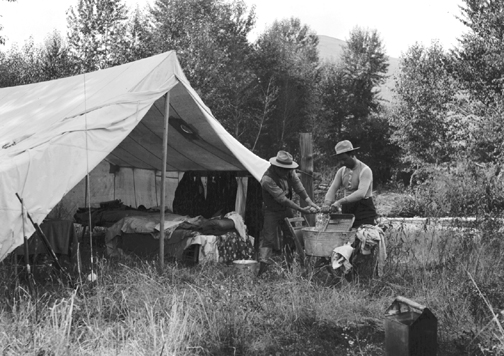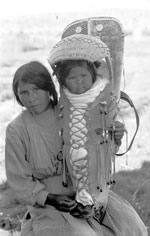Wisconsin Indian Image Galleries
The Wisconsin Indian galleries contain historical and modern images pertaining to various aspects of Native American culture.
Browse by category.
Browse by category.

Despite changes wrought by contact with Euro-American cultures and societies, Native people in the Great Lakes region have maintained a strong sense of communal life and family organization, and have persevered in many traditional ways of life while simultaneously accommodating themselves to American society and its economy.
The Ojibwe stretch from present-day Ontario in eastern Canada all the way into Montana. Oral traditions of the Ojibwe, Ottawa, and Potawatomi assert that at one time all three tribes were one people who lived at the Straits of Mackinac. From there, they split off into three different groups. Linguistic, archaeological, and historical evidence suggests that the three tribes do indeed descend from a common ethnic origin.
 American Indian Cradles and Cradleboards - The Museum’s collection of cradles, cradleboards, and associated accoutrements includes nearly 200 items.
American Indian Cradles and Cradleboards - The Museum’s collection of cradles, cradleboards, and associated accoutrements includes nearly 200 items.
Deer and moose were hunted as well as several kinds of fox -- red, the black, and silver gray. Timber wolves, a large prairie wolf, and a smaller prairie wolf that was not considered very good eating were also hunted. The bear was not killed without a special ceremony and apology, for this animal was greatly revered.
Although the Plains Indians had no written language in which to record their history, they did have a long tradition of preserving oral histories pictorially. For centuries, Plains Indian men kept historical records of their tribes, first with petroglyphs and pictographs on rock walls, and then painted on buffalo hides.
Oral traditions of the Potawatomi, Ojibwe, and Ottawa assert that at one time all three tribes were one people who lived at the Straits of Mackinac. From there, they split off into three separate groups, and the Potawatomi were "Keepers of the Sacred Fire." As such, they were the leading tribe of the alliance the three Indian nations formed after separating from one another.
In the beginning, Earthmaker sat in space and there was nothing around him. He became conscious and realized there was nothing there. He wondered what he should do, and he began to cry. Tears flowed from his eyes and fell down below him. He looked down and saw something bright: it was his tears which had fallen and formed the oceans, lakes, and streams. Earthmaker thought some more. He realized that if he thought of something, it would simply appear. He thought of light and it became light.